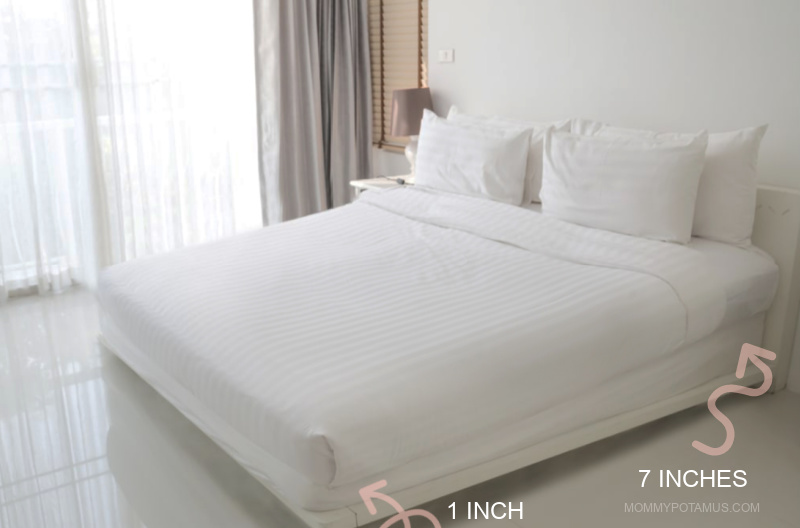
A couple of years ago, my functional medicine MD suggested raising the head of my bed by six inches to support my brain’s internal detoxification system. While it’s definitely not the only “out of the box” suggestion he has ever made, it might the weirdest . . . so of course I had to research it.
Though modern inclined bed therapy can be traced back to the work of British mechanical engineer Andrew K. Fletcher, the practice of sleeping on an incline isn’t actually new at all. Many of the beds created for Egyptian royalty were crafted with a roughly five degree incline – this Museum of Fine Arts Boston reproduction of Queen Hetepheres the 1st’s bed is a great example.
If you’re thinking, “But WHY?” . . . you’re not alone.
Proponents say it harnesses gravity to optimize circulation and other physiological functions during sleep, and there is some evidence to support this idea.
We’ll cover the research below along with other potential benefits, but first I want to mention that none of these statements have been evaluated by the FDA, this article is not medical advice, and it is not meant to diagnose or treat any condition. Now that we’ve got that out of the way, let’s dive in.
- What exactly is inclined bed therapy?
- Animals, NASA & Intracranial Pressure
- Benefits of Inclined Bed Therapy
- 1. May Support Brain Detoxification
- 2. Eases Heartburn Symptoms
- 3. Supports Airway Flow
- My Experience With Inclined Bed Therapy
- What can I use to elevate the head of my bed?
- Who should not use inclined bed therapy?
- More Wellness Articles
What exactly is inclined bed therapy? ^
Inclined bed therapy basically just means raising the head of your bed by a few inches – usually so that it’s at a roughly five degree angle. For most queen and king mattresses, about six inches does the trick.
There are a few common methods for creating the incline – some people use wood or cement blocks, others use bed risers, and others use these wedges that slide under your mattress. The important thing is just to make sure the bedframe is stable before you tuck in for the night.
As I mentioned above, its ancient origins go all the way back to Tutankhamun’s reign, but modern IBT can be traced back to a curious engineer named Andrew Fletcher.
He wondered how trees like the Giant California Sequoia manage to defy gravity and pull water all the way up from their roots to their canopies. After experimenting with fluid dynamics, he concluded that it was changes in fluid density that interact with gravity to create a circulatory effect in trees. Essentially, dense sap gets pulled down, and then lighter water gets pulled up via molecular drag.
He theorized that gravity might play a similar role in human circulation, which pumps salt-infused (dense) blood to our bodies that is eventually filtered by the kidneys (removing salts and becoming less dense) as it makes its way back to our heart. After more experimentation, he became convinced that it does.
Interestingly, published research on our brain’s detoxification system (the glymphatic system) has concluded that both gravity and body position do play a role in the flow of cerebrospinal fluid to and from the brain during sleep. (1)
Specifically, lying flat (on either our back or stomach) increases intracranial pressure and reduce glymphatic flow, while side sleeping (especially right side sleeping) increases flow. In terms of why the right side seems to be best, some experts theorize it has to do with how gravity interacts with the heart in that position.
Interestingly, patients with certain kinds of heart conditions instinctively prefer sleeping on their right side. (2)
Animals, NASA & Intracranial Pressure ^
Speaking of nighttime habits, sleep psychologist Dr. Günther W. Amann-Jennson once noted that “wild animals and domestic livestock all have a natural preference for sleeping on the ground with their heads slightly uphill.” (3)
That observation:
led him to study the role that gravity plays in our sleep processes. When we are awake and standing upright, our heads are above our hearts and our blood flows against gravity from the heart up to the brain. But when we go to sleep, we lie horizontally; our hearts and heads are at the same level, which eliminates the effects of gravity on brain circulation and increases the pressure inside the skull, or intracranial pressure. Dr. Amann-Jennson believes that this pressure increases throughout the night, causing extra fluid to accumulate in the brain chambers, ventricles, and neurons.
. . . . This suggests that we need the benefits of gravity to get healthy sleep, and that, like animals in the wild, we should be sleeping with our heads above our hearts.” – Dave Asprey, Game Changers (3)
You know who else cares a lot about increased intracranial pressure? NASA.
That’s because without the benefit of gravity our circulation gets all wonky. Or as they put it:
There’s no gravity to pull blood into the lower part of the body. Instead, blood goes to the chest and head, causing astronauts to have puffy faces and bulging blood vessels in their necks.
And appearance isn’t the only ugly side effect. The lack of blood flowing to and from the brain can cause astronauts to feel dizzy and sometimes even faint when they return to Earth’s gravity.” (4)
The increased intracranial pressure can cause other issues, too, like visual impairment intracranial pressure (VIIP) syndrome. (5)
NASA has spent a lot of time and money trying to figure out how to counteract “gravity deficiency” in space, and one experiment is particularly worth talking about. They paid participants $18,000 to lie in bed for three months to study the detrimental effects and try to counteract them. (6)
Except the beds weren’t flat, they were tilted head-down at a six degree angle. So the question is not whether gravity impacts circulation when we’re in bed – it definitely does, just ask the miserable participants in NASA’s study – it’s whether a flat or slightly inclined position is optimal.
WIth that in mind, let’s take a look at the research.
Benefits of Inclined Bed Therapy ^
Sleep is our natural repair mode, and getting consistent deep sleep can make us smarter, happier, more productive and more creative. (7) (8) (9) (10) (11) Proponents of inclined bed therapy say the practice enhances our overall sleep quality in several ways, including supporting glymphatic system detoxification, healthy circulation, reducing pressure on the sinuses/airway and more.
Here’s what the research says:
1. May Support Brain Detoxification ^
Sometimes referred to as “the good kind of brainwashing,” our brain has a rinse cycle that is most active when we sleep. Called the glymphatic system, it works by piggybacking on cardiovascular pulsations to fill channels in our brain with cerebrospinal fluid. The fluid delivers nutrients and flushes out toxins like β-amyloid protein, which can cause cognitive decline when it builds up. (12)
As I mentioned above, my functional medicine MD suggested that I try inclined bed therapy with the goal of supporting glymphatic flow. He learned about it from a mentor that he deeply respects and sometimes recommends it in his practice.
I’m not aware of any research that directly looks at how raising the head of the bed impacts glymphatic clearance specifically, but we do have research on the opposite approach.
In this study, researchers studied the effects of the Head-Down-Tilt (HDT) position, which tilts the head downward instead of upward. They found that HDT decreased the amount of slow wave (deep) sleep a person got while increasing jugular congestion and intracranial pressure. The study authors specifically mention poor glymphatic function as a likely consequence of the head-down-tilt position.
More research is definitely needed, but the potential impact of inclined sleep therapy on glymphatic function is intriguing.
2. Eases Heartburn Symptoms ^
In one study, researchers raised the head of heartburn patients bed by 20 centimeters (about 8 inches) by placing a solid block under the head of the bedframe. They found that it helped relieve heartburn symptoms by using gravity to keep stomach acid where it’s supposed to be instead of creeping up into the esophagus (which can happen when lying flat).
The researchers also noted that participants slept better due to the symptom relief they experienced. (13)
3. Supports Airway Flow ^
Gnawing on hunks of dried meat may not be tasty, but it does wonders for developing the lower jawbone. (14) Unfortunately as how and what we eat has changed over generations, so has our orofacial development, and not often for the better.
Our faces are becoming more narrow overall, leading to smaller airways and an increased percentage of people who experience sleep disordered breathing. (15) When we sleep, the muscles in our upper airway tend to relax and our tongue falls toward the back of our mouth, which may restrict airflow if the airway is not optimally developed. (16)
Research suggests that inclined bed therapy may support airway flow by changing how gravity influences our jaw position. I recently did an at-home sleep study that compared inclined sleeping to flat bed sleeping, and I’ll share more about my results later in this article.
For now, though, I want to mention that a lot of research points to head-of-bed-elevation (HOBE) therapy as helpful for supporting airway function.
In one study done with participants who had mild to moderate sleep apnea, sleeping on a 20 centimeter incline reduced symptom severity while also increasing sleep efficiency. (17)
According to the researchers, similar studies had noted that volunteers don’t like sleeping on wedge pillows that only incline from the waist up, so they adopted a “bed angulation” approach that sounds similar (or identical) to the one described in the heartburn section above (a solid block placed under the head of the bedframe).
They also proposed that head-of-bed-elevation therapy could be a great option to use in combination with other interventions and suggested doing more studies that use it alongside an oral appliance or oropharyngeal exercises.
I’m not sure if those studies are underway yet, but I’m a huge fan of the Vivos mmRNA device for improving nighttime breathing. They have an adult appliance and a kid-version for helping little ones optimize orofacial/airway development.
My kids have been wearing their pediatric devices for years, and it has made a huge difference for them. I’ll write more about our experience soon, with details on sleep studies and photos. It’s been such a great experience that I’m not just a happy client, I’m a company advisor and investor, too. (And just in case you’re wondering, I did pay full price for my kids services.)
My Experience With Inclined Bed Therapy ^
I recently conducted a two-night sleep study to check for sleep apnea, and because I’m such a curious person I decided to sleep on an incline the first night (like I normally do) and then drop the bed back into the flat position for the second night. It turns out I don’t have sleep apnea, but my sleep efficiency and oxygen saturation levels were both better when I was sleeping inclined.
In other words, I spent the same amount of time in bed both nights, but I got more sleep when my bed was inclined and my cells got more oxygen. This is one biohack I’ll be sticking with.
A note on making transition:
Many IBT proponents suggest raising the head of your bed in small increments to make the adjustment easier. I didn’t do that because the risers I bought were six inches high and I didn’t want to have to MacGuyver random wood blocks under my bedframe until I’d worked up to that height.
So . . . for the first few nights I definitely felt the effect of gravity. Sometimes I felt like I was sliding down, and sometimes my covers actually did. But after that it felt completely normal, my covers stayed in place, and I started waking up feeling more rested.
Although many people with back pain say it helps ease their discomfort over time, some people (like my husband) do experience some soreness during the adjustment period. It’s thought that this may be due to how sleeping on an incline elongates and aligns the body.
What can I use to elevate the head of my bed? ^
Most adjustable beds bend in the middle so that the top half rises and the lower half stays horizontal. With IBT, the goal is to maintain a flat bed surface while creating a slope from the head-of-the bed downward to the food of the bed.
My doctor suggested that I aim for a roughly 5 degree incline, and as I researched I found that 3.5-5 degrees seems to be the most frequently recommended range. For most standard king or queen beds, that means raising the head of the bed by about six inches.
Folding just the head of the bed up with an adjustable bed frame will not work, the entire bed has to be on a slope. For a standard king or queen sized bed, this comes out to adding roughly 6 inches of height to the head of the bed. Adding 3 inches of support to the middle of the bed frame may also be needed for stability. You can buy 6 inch risers online for about $10, or use books, bricks, or wood.
This can be accomplished in a few different ways:
Bed risers, blocks, etc. – The Mayo clinic recommends using wood or cement blocks to elevate the head-of-the-bed by 6-9 inches to reduce reflux symptoms. (18) Some people also add 3 inch risers to center legs of the bedframe (if they’re present) to offer additional stability.
Mattress Elevator – Made with CertiPUR foam, these wedges slide under the whole mattress so that it slopes gently. This one is 7 inches near the top and 1 inch at the bottom, which creates the desired six inch incline. It can be purchased with a cover or without. This one is similar but a little more pricey.
Who should not use inclined bed therapy? ^
According to the U.S. Consumer Product Safety Commission, surfaces that incline more than 10 degrees are not safe for babies. They tested a number of products that had been the subject of real-life adverse incident reports and found that none were safe. There are a few reasons for this, including that babies heads are disproportionately heavy in relation to their bodies, which can cause their head to fall forward and block the airway.
The CPSCs expert, Erin Mannen, Ph.D., a mechanical engineer specializing in biomechanics, concluded that “products with inclines 10 degrees or less, with flat and rigid surfaces, are likely safe for infant sleep. Dr. Mannen also found that soft and plush-like sleep surfaces pose dangers to infants.” (19)
Starting in mid-2022,l products intended for infant sleep will have to meet a federal safety standard in order to be sold.
According to the sleep apnea study mentioned earlier in this article, inclined bed therapy may also be contraindicated for individuals “with specific conditions such as lower limb edema and venous insufficiency.” (17)
More Wellness Articles ^
5 Weighted Blanket Benefits & How To Choose One – Research shows that weighted blankets help with sleep, reduce stress, improve daytime focus and mood, and ease symptoms associated with sensory processing disorder and other concerns. In this article I’ll dive into how they work, plus tips for choosing the right one for you.
Benefits of Sunlight + FAQs – We’ve known for years that sunlight helps us synthesize vitamin D in our skin, but emerging research suggests that it may have health benefits that are totally separate from vitamin D production, too. Here’s how it benefits sleep, mood, gut health, blood pressure and more.
Want more research-backed natural remedies?
No problem, I’ve created a free ebook for you – Kitchen Apothecary: 25+ Natural Remedies Using Ingredients From Your Pantry – as a gift for signing up for my newsletter. You’ll also get updates when I post about safe essential oils for pregnant/breastfeeding mamas, exclusive gifts and coupons (I was able to give away a jar of free coconut oil to anyone who wanted it recently!), plus other goodies.
Sign up using the form below.
Sources
- Lee, Hedok et. al. (2015) The Effect of Body Posture on Brain Glymphatic Transport
- Leung, Richard S.T et. al. (2003) Avoidance of the left lateral decubitus position during sleep in patients with heart failure: relationship to cardiac size and function
- Asprey, Dave (2018) Game Changers: What Leaders, Innovators, and Mavericks Do to Win at Life
- NASA (2007) Cardiovascular System Gets ‘Lazy’ in Space; New Study Gets Blood Flowing on Station
- Van Ombergen, Angelique et. al. (2017) The effect of spaceflight and microgravity on the human brain
- VICE (2014) NASA Is Paying Me $18,000 to Lie in Bed for Three Months
- Scientific American (2008) Sleep On It: How Snoozing Makes You Smarter
- PBS (2012) Can Sleep Make You Smarter?
- BBC (2013) How Sleep Makes Your Mind More Creative
- American Psychological Association (2014) Sleep Deprivation: More Sleep Would Make Most Americans Happier, Healthier and Safer.
- Stump, Scott (2013) “Nap Rooms” Encourage Sleeping On The Job To Boost Productivity
- M. Paul Murphy and Harry LeVine III (2010) Alzheimer’s Disease and the β-Amyloid Peptide
- Khan, Bashir Ahmad et. al. (2012) Effect of bed head elevation during sleep in symptomatic patients of nocturnal gastroesophageal reflux (GERD)
- Karamani, Ioanna I. et. al. (2022) Impact of Diet Consistency on the Mandibular Morphology: A Systematic Review of Studies on Rat Models
- Anandarajah, Seerone et. al. (2017) Risk factors for small pharyngeal airway dimensions in preorthodontic children: A three-dimensional study
- Guilleminault, Christian et. al. (2019) Sleep-Disordered Breathing, Orofacial Growth, and Prevention of Obstructive Sleep Apnea
- Souza, Fábio José Fabrício de Barros et. al. (2017) The influence of head-of-bed elevation in patients with obstructive sleep apnea
- Mayo Clinic. Gastroesophageal reflux disease (GERD)
- United States Consumer Product Safety Commission. Safe Sleep – Cribs and Infant Products




